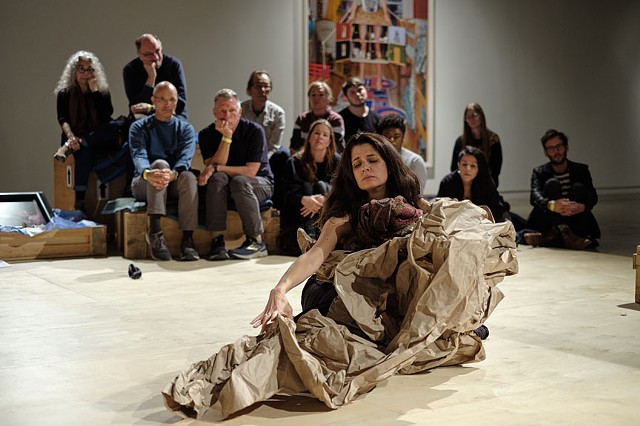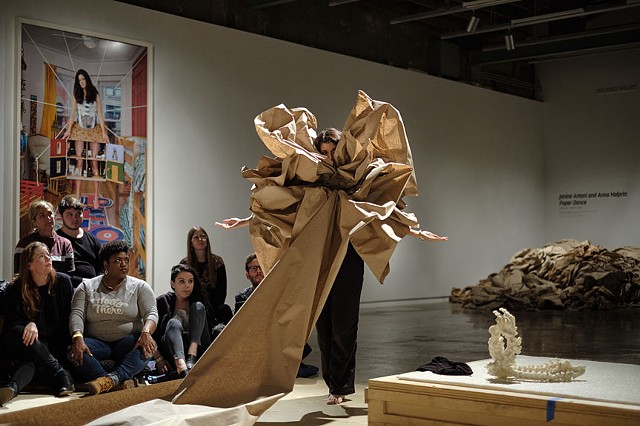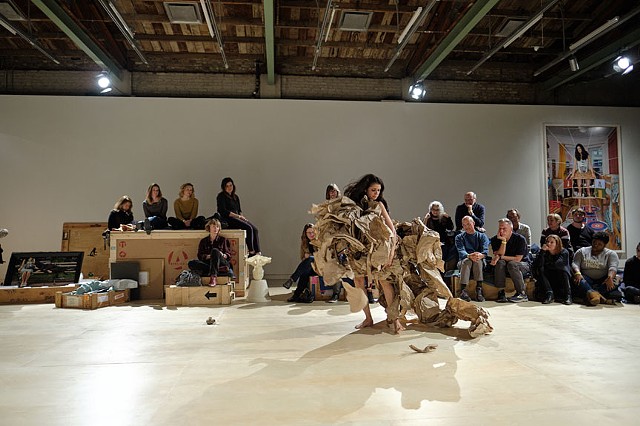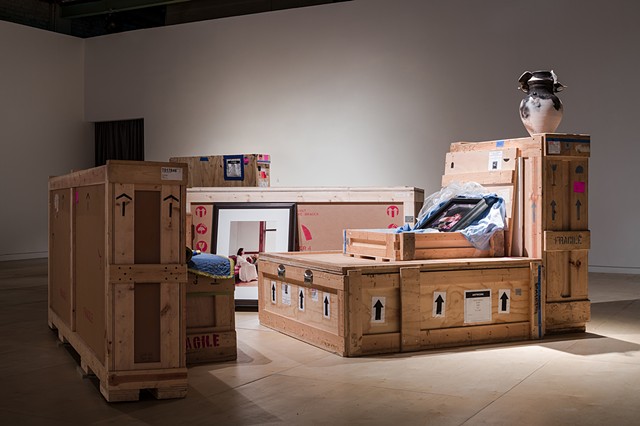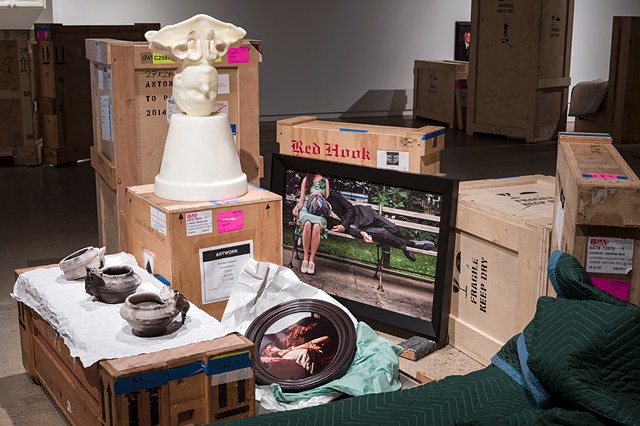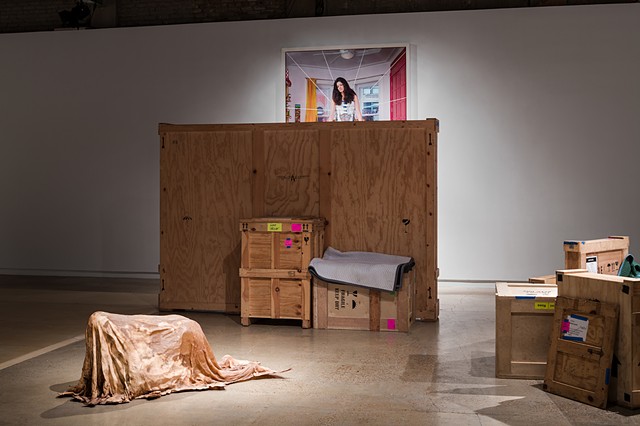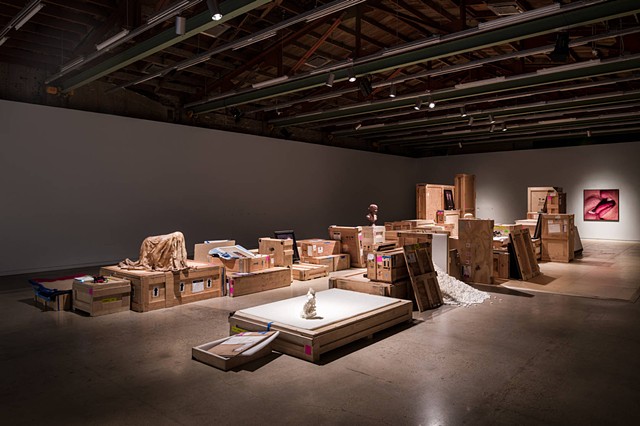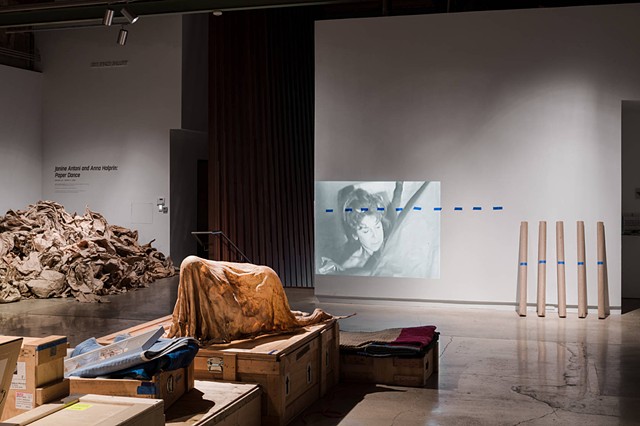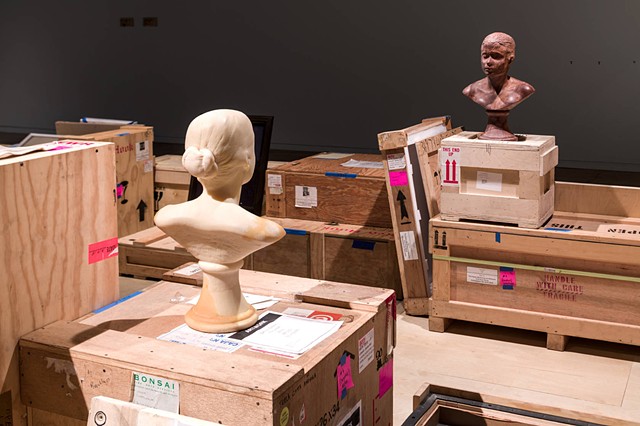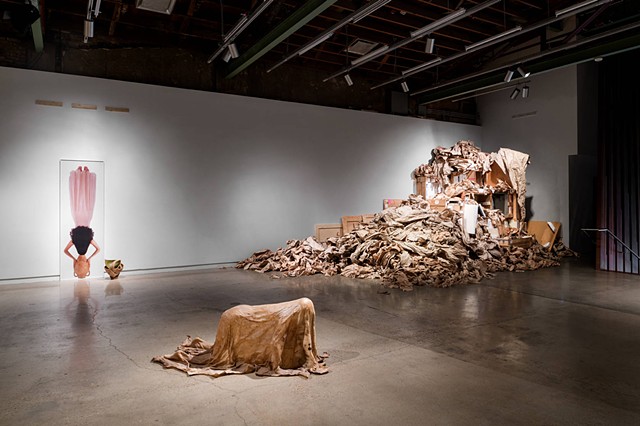JANINE ANTONI AND ANNA HALPRIN: PAPER DANCE | The Contemporary Austin | 2019
JANINE ANTONI AND ANNA HALPRIN: PAPER DANCE
JANUARY 23 – MARCH 17, 2019
On view at The Contemporary Austin – Jones Center on Congress Avenue
This exhibition is organized by Julia V. Hendrickson, Associate Curator, in collaboration with Andrea Mellard, Director of Public Programs and Community Engagement, The Contemporary Austin. Text is by Hendrickson.
CURATORIAL STATEMENT
Paper Dance is both a retrospective spanning thirty years of work by the New York–based artist Janine Antoni (Bahamian, born 1964 in Freeport, Grand Bahama) and a solo dance performance developed in collaboration with pioneering dancer and choreographer Anna Halprin (American, born 1920 in Wilmette, Illinois). On view on the second floor of the Jones Center, The Contemporary Austin’s downtown venue, Paper Dance consists of a wooden dance floor and thirty-nine crates containing thirty-eight works of Antoni’s sculpture and photography from 1989 to the present. During the exhibition, Antoni will present a series of performances within the gallery. Throughout each performance the artist will reposition and uncrate artworks so that the space changes and evolves over time, highlighting three exhibition cycles that address major themes of Antoni’s work: absence, motherhood, and identity. [1]
If the framework for the Paper Dance performance is a shifting arrangement of Antoni’s sculpture and photographs, the constant is Antoni herself, moving throughout the installation with a long roll of brown paper. Antoni wraps, tangles, and rolls her body, alternately clothed and nude, in and out of the paper’s sculptural folds as she responds to her past works in the present moment. Each performance is an opportunity to see the artist address the sculptural language she has developed throughout her career. In her words, Paper Dance takes Antoni’s studio process and makes it visible: “I am performing the act of making, and the audience witnesses my thinking in space.” [2]
Paper Dance has a rich and evolving history, both for Antoni and the presence of dance within contemporary art. Created in 2013, Antoni first performed Paper Dance publicly in 2016, as part of her larger exhibition Ally at The Fabric Workshop and Museum in Philadelphia. Developed by performance scholar and curator Adrian Heathfield, the exhibition featured collaborative projects between Antoni, Halprin, and dancer-choreographer Stephen Petronio. Twenty-one performances of Paper Dance gradually formed a “slow-time retrospective” of Antoni’s career. [3]
A similar series of movements unfolding over time will activate The Contemporary Austin’s exhibition. In this iteration of Paper Dance, the behind-the-scenes logistics of packing and unpacking, installing and de-installing artwork by the artist and art handlers is an integral, public, and performative component of the exhibition. Over the course of fifteen unique dance performances, Antoni will reveal a selection of artworks that remain on view in three separate exhibition cycles. Each cycle highlights an overarching theme that has arisen throughout Antoni’s career.
Early iterations of Paper Dance took place between 2013 and 2015, with Antoni performing multiple times on Halprin’s legendary Mountain Home Studio Dance Deck in Kentfield, California, located outdoors against a sublime backdrop of sky and trees. [4] Since the early 1950s, the deck has hosted generations of dancers and choreographers, such as Trisha Brown, Merce Cunningham, Simone Forti, and Yvonne Rainer. [5] In one of their first interactions on the deck, Halprin handed Antoni a long roll of brown paper and said, “You might consider taking off your clothes.” [6] Halprin gave Antoni the simple constraints of a prop and a space to move within; Antoni’s task was to render it personally meaningful.
The score of Paper Dance has its roots in a groundbreaking theatrical work of Halprin’s: Parades and Changes. First performed in Sweden in September 1965 (by dancers including Halprin, her two daughters Daria and Rana, A.A. Leath, John Graham, and others), this evolving series of interchangeable, scored scenes often features dancers in business suits enacting the everyday task of dressing and undressing. While never performed exactly the same way—dancers are instructed on what to do, not how to do it—one key, defining score of the piece includes the dancers’ nude bodies interacting with brown paper. In this score, electronic music pioneer Morton Subotnick’s audio arrangement of electronic sound and mid-1960s pop songs plays while the sound of the paper, rustling and crumpling, fills the space. The intentional incorporation of nudity in Parades and Changes—a revolutionary moment in the history of modern dance—caused little fanfare in Europe, but when Halprin brought it to New York in 1967, the work caused an uproar. Revivals of the classic work have since been performed dozens of times, including most recently at the Centre Pompidou, Paris (2008); REDCAT, Los Angeles (2009); Performa, New York (2009); and the Berkeley Art Museum and Pacific Film Archive, University of California, Berkeley (2013). As an acknowledgement of this history and artistic lineage, an extract of a filmed recording of Parades and Changes (the 1965 performance in Sweden) is incorporated into the Paper Dance exhibition.
While perhaps best-known as a sculptor, over the last thirty years, Antoni has created a wide range of work that consistently utilizes elements of dance and performance. The artist notes, “I have been exploring the line between performance, object, and relic in order to see how the emphasis on one or the other changes its reading. If there is one thing that my past work has focused on, it is how to put the performance of the making into the object.” [7] In dialogue with conceptual and feminist art of the 1970s and 1980s, Antoni’s hybrid artistic practice merges the unpredictability and experimental nature of “live art” with the physical materiality of sculpture, photography, and installation, using her body as a primary medium. Both the artist’s sense of self and notions of the female body are inextricable from Antoni’s work: as she has said, “The only thing I know and trust is my own experience.” [8]
Antoni’s career began in the early 1990s, influenced by feminist critique of the 1980s—such as that of Barbara Kruger, Sherrie Levine, and Cindy Sherman—yet also drawing from the visceral language of 1970s feminist artists who used their bodies in radical ways—including Marina Abramović, Ana Mendieta, Carolee Schneemann, and Hannah Wilke. While these earlier artists were known for their raw physicality and aggression, Antoni establishes a clear departure from them by emphasizing tenderness within her critical rigor. Antoni’s early work is distinctive in that she uses her teeth, tongue, hands, hair, and eyelashes to transform unusual materials like chocolate, hair dye, lard, and soap into new shapes and forms. Typically, the physical object remains as evidence or residue of the performative act of making, as in Gnaw (1992), Lick and Lather (1993), Eureka (1993), or and (1996–1999). Her live performance works include Loving Care (1993), in which the artist mopped the gallery floor with her hair soaked in “Natural Black” Loving Care hair dye, painting the audience out of the room—the gendered labor of mopping the floor an everyday gesture in conversation with the history of Abstract Expressionism. In Slumber (1993), Antoni slept on a bed in a gallery, dreaming while an EEG machine recorded her rapid eye movement. When she awoke, Antoni used pieces of her nightgown to weave her dream pattern into a long blanket.
Antoni has also created highly composed photographic works that imply performance, such as Tangent (2003) and Conduit (2009). Other works like Caryatid (2003) combine photography and sculpture to reference and undermine perceptions of performance and process. In her video works she also performs for the camera’s perspective, such as in Touch (2002), a video installation filmed on the Bahamian beach outside her childhood home. The artist’s body enters from outside the frame, balancing on a tightrope, which for a moment dips to touch the horizon. Pointing to the process of making and creating as a performative action full of meaning, the artist’s body itself is a tool and a material.
Antoni’s work is performative at its core, with the body playing an active role in the artist’s sculptures, photographs, and videos over the past thirty years. In this context, Paper Dance is quintessential to her oeuvre, a critique of the tropes of the artist’s retrospective. Considering this exhibition in relation to Halprin’s gift to her of the open score from Parades and Changes, Antoni asks, “If Anna can breathe new life into a work that she made in 1965, why can’t I treat my past work in the same malleable way?” [9] As an answer, rather than presenting information about the past as linear, organized, or didactic, Antoni offers us glimpses into her work in ways that are atemporal, nuanced, mutable, and very much still alive.
[1] This is the artist’s second collaboration with The Contemporary Austin. In 2015 Antoni was invited to Austin with Stephen Petronio to present Incubator, an exhibition of collaborative and solo video, sculpture, and photography. The project, which also included private performances of On the Table, 2015, was co-sponsored by The Contemporary Austin and testsite, Austin, and exhibited at testsite from May 3 - July 26, 2015.
[2 ]Janine Antoni, phone conversation with Julia V. Hendrickson, October 11, 2018.
[3] “Paper Dance,” in Ally, ed. Adrian Heathfield (Philadelphia: The Fabric Workshop and Museum; Munich: Hirmer Publishers, 2017), 35.
[4] One of these dances was documented in a 2015 film directed by Hugo Glendinning.
[5] Completed in 1954, the dance deck was designed by Anna’s husband, renowned landscape architect Lawrence Halprin, with theater architect and designer Arch Lauterer, as part of Anna and Lawrence’s home. See Janice Ross, Anna Halprin: Experience as Dance (Berkeley: University of California Press, 2007), 79; 103–107.
[6] Janine Antoni, in conversation with Julia V. Hendrickson and others, March 8, 2018.
[7] Janine Antoni, e-mail correspondence with Julia V. Hendrickson, October 22, 2018.
[8] Janine Antoni, quoted in Amy Cappellazzo, “Mother Lode,” Janine Antoni (Küsnacht, Switzerland: Ink Tree Edition, 2000), 102.
[9] Janine Antoni, e-mail correspondence with Julia V. Hendrickson, October 9, 2018.
EXHIBITION PRESS & REVIEWS
Carney, Sean J. Patrick. "Installation as Choreography: Janine Antoni in Austin." Art in America. March 14, 2019.
Copeland, Colette. "Paper Dance: A Conversation with Janine Antoni." Glasstire. March 2, 2019.
Gwillim, Christine. "Can paper be a body?" Sightlines. February 26, 2019.
Curatorial text for Rotation A: Motherhood
January 23 – February 3, 2019
The foundation of Paper Dance lies in the intergenerational relationship between Janine Antoni and Anna Halprin, whom Antoni has described as a kind of artistic mother, a mentor, and a friend. At the core of Antoni’s practice is the female body, matrilineage, feminist empowerment, and the artist’s relationship to motherhood. Her work from the 1990s tackles the subject of the artist’s mother, and Antoni’s experience of being a daughter. In 2004, she gave birth to her own daughter, and a new chapter on motherhood emerged. The photograph One Another, 2008, a tender, domestic scene of Antoni’s daughter holding a spoon up to the artist’s belly button—recalls the imagery of the sterling silver sculpture Umbilical, 2000. Another series of photographs, including Inhabit, 2009, Host, 2008, and Up Against, 2009, features a classic childhood object, a dollhouse, playing with scale and perspective to open up new ideas of mothering and home.
In this thematic rotation, organized around the idea of motherhood, a total of eighteen artworks by Antoni will gradually be unpacked and installed. During five intimate dance performances, the artist responds to her own work, arranged in a circular “nest” around the dance floor, using her body and brown paper to create sculptural shapes and gestural images. At times in Antoni’s interaction with the malleable paper there are arresting moments of care and gentleness, reminding us of a mother’s touch. Following the fifth performance, the galleries are reinstalled in a new way that resonates with the motherhood theme. Now, the crates are installed in tableaus—cave-like spaces that embrace the viewer—encouraging intimacy and emphasizing the knowledge that comes from closeness. Nestled within each space are small groupings of artworks evoking mother-daughter relationships, nurturing, and spirituality.
Curatorial text for Rotation B: Identity
February 5 – 24, 2019
Janine Antoni’s career was shaped early on by her inclusion in the controversial 1993 Whitney Biennial, a group exhibition that—in the wake of the 1980s AIDS crisis and the Reagan culture wars—thrust the term “identity politics” to the forefront of contemporary art. The biennial was reviled by critics as “rough and vulgar,” but is now seen as groundbreaking. Antoni and peers such as Glenn Ligon and Byron Kim presented work that challenged the art historical canon while tackling very personal issues around sexuality, gender, race, and culture. Since then, Antoni has continued to reference her self—particularly her body and her biography—as an artistic source. In Lick & Lather, 1993, she uses her body to sculpt self-portraits in chocolate and soap, classical yet imperfect busts that reveal the residue of her process. Uncompromising photographic works like Mortar & Pestle, 1999, break down assumptions about gender and its performance, questioning what is masculine or feminine.
In this thematic rotation, organized around the idea of identity, a total of fourteen artworks by Antoni will gradually be unpacked and installed. During five intimate dance performances, the artist responds to her own work, arranged in a circular “nest” around the dance floor, using her body and brown paper to create sculptural shapes and gestural images that express identity. At times Antoni uses the malleable paper to morph her body, playing with gender tropes. Following the fifth performance, the galleries are reinstalled in a new way that resonates with the identity theme. Now, the crates form two parallel rows, on which this retrospective of Antoni’s artwork is installed. An early work faces a later work, highlighting how content reemerges and transforms in relationship to the artist’s life experience.
Curatorial text for Rotation C: Absence
February 26 – March 17, 2019
Since the 1990s, Janine Antoni has utilized her own body as part of an exploration of her self, and a desire to connect with—or know—others. As much as the artist is present and visible in her own work, Antoni’s use of absence, both in concept and in visual representation, has been critically overlooked. Her engagement with this idea can be both haunting and lled with longing. For instance, the bronze work Unveiling, 1994, is on one hand a bell that calls out sound, but hung from the ceiling at the artist’s exact height it suggests her absent body as if covered in a veil. The otherworldly sculpture Saddle, 2000, outlines the ghostly shape of the artist’s crouching figure in a hardened rawhide cast. A 2015 series of cast sculptures, including to long, reference milagros, or religious offerings used in Latin American cultures, their hollow forms emanating a deep sense of spirituality and loss.
In this thematic rotation, organized around the idea of absence, a total of twelve artworks by Antoni will gradually be unpacked and installed. During five intimate dance performances, surrounded by audience members sitting on crates filled with unseen artworks, the artist responds to her own work, arranged in a circular “nest” around the dance floor. Antoni uses her body and brown paper to create sculptural, gestural shapes that leave their traces in the paper, generating a memory of her movement scattered behind her. Following the fifth performance, the galleries are reinstalled in a new way that resonates with the absence theme. Now, piled high in the corner is a stack of emptied crates and crumpled paper, a relic from past performances. Antoni’s artwork is installed throughout the front of the gallery while the dance floor becomes a pedestal for a mountain of crates containing other absent, unseen works.
PERFORMANCE & INSTALLATION VIEWS
